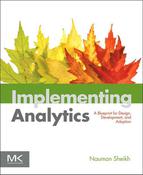Conclusion
In the Introduction, the four objectives for writing this book were listed: simplification, commoditization, democratization, and innovation. This chapter sums up the entire book’s contents in support of meeting those objectives.
Objective 1: Simplification
The simplification objective is achieved at several levels, as follows.
Simplified Definition
When a technology or concept is overhyped in the market, it becomes very difficult for new entrants to filter out the marketing buzz. In case the of analytics, the mathematics, statistics, and machine learning theories (data mining) are already very complex and intimidating, let alone understanding their proper application and implementation in a commercial organization. Therefore, Chapter 1 defines an analytics solution and puts it in a business context. As stated numerous times, the purpose is to simplify the definitions so they can be adopted and implemented, therefore the definitions have been kept very simple. Once an organization successfully implements their first project, demonstrates value, and the IT and business sides become confident and excited, a more sophisticated deep-dive into the algorithms and techniques will evolve naturally.
Demystifying Analytics Techniques
Chapter 1 uses just four techniques as an arbitrary way to limit the complexity of available analytics techniques. Also, the techniques chosen and explained are simpler to understand compared with, let’s say, social network analysis or association rules, which are difficult to apply in a direct and relevant business context. Being introductory material regarding analytics, the techniques chosen were explained further through examples in Chapter 3 on using analytics. What readers will find is predictive analytics is the most powerful of all the available techniques, which has been explained in great lengths in terms of concept, examples, implementation details, and even planning and design suggestions throughout Chapters 4 and 5, as well as Chapters 7, 9, and 10.
Simplifying Implementation Details
Chapters 9 and 10 cover the IT and implementation in quite a bit of detail, emphasizing the tasks, deliverables, roles, responsibilities, and skills needed to put a team together that can deliver analytics solutions repeatedly and consistently. Chapter 11 covers Big Data, Hadoop, and cloud computing to complete the technology landscape surrounding analytics solutions. Similar to the analytics definition, these concepts are also in their infancy from a maturity and wide adoption perspective, and therefore it is important to filter material content from marketing buzz.
Objective 2: Commoditization
Commoditization refers to using readily available tools and existing infrastructure that are usually available within an organization, such as ETL tools, a data warehouse system, etc. Chapter 5 shows how decision strategies can be implemented using an existing ETL toolset that includes messaging or service-oriented integration platforms. Chapter 9 details the implementation methodology and shows how an existing data warehouse environment should be used, and Chapter 6 introduces and emphasizes this same point. Chapter 2 on data utilization presents a comprehensive tool that organizations can use to see where they stand on this Information Continuum. Once they place themselves, they can see the existing toolsets, skills, and infrastructure available to them and how to build from there to get to analytics solutions dealing with models and decision strategies.
Objective 3: Democratization
Democratization refers to making analytics available to a wider audience compared with a select few. Chapter 7 takes an example and emphasizes the business case and demonstrated value allowing for a wider audience to take notice. Democratization has three different perspectives. The first is making analytics solutions available to an entire organization and not just a small set of specialized areas. This point is made repeatedly in several chapters, especially in Chapter 5 on decision strategies. The second perspective applies to industries that have traditionally not adopted analytics as a tool for competitive advantage. Industries like shipping and logistics, education, the public sector, etc. are not well known for their use of analytics. They can now adopt the simplified and commoditized analytics solutions, as the initial solutions will be cost effective, and once value is demonstrated, skills are developed, and a culture emerges, it becomes easier to become an analytics-driven organization. Chapter 3 on using analytics provides numerous examples from a wide cross-section of industries to help readers see a pattern within those examples and then start to look for opportunities within their industry. The third perspective is focused on midsize organizations that have the same problem as a large corporation but may be smaller in scale. A regional bank, for example, that has a small credit derivatives portfolio cannot hire a team of experienced traders or invest in high-end analytical tools to run an efficient derivatives trading desk. With a simplified and commoditized solution, they now have an opportunity to apply portfolio optimization and forecasting techniques to improve their returns and use predictive modeling to manage their risk more effectively.
Objective 4: Innovation
Does analytics allow a business to become innovative? The approach taken in Chapter 3 uses examples across various functions and industries where analytics can provide a competitive edge. The real case for innovation comes through in Chapter 8 on requirements and scope. Identification of a problem or realization of an opportunity is at the heart of becoming an innovative business using analytics. The analytics models aside, the decision strategies explained in great detail in Chapter 5 show how output from an analytics model can be used to innovate within business operations through small incremental gains. If eventually an organization is able to instill a thinking culture along these lines, then there is no end to human creativity yielding value for the business.
A decision strategy–driven culture with output coming from models that are always updated based on changing business environments starts to make middle managers and then even line workers get into the habit of constantly innovating and evolving their decision strategies for maximizing value. They would almost start to become innovative business executers by habit (Duhigg, 2012).
